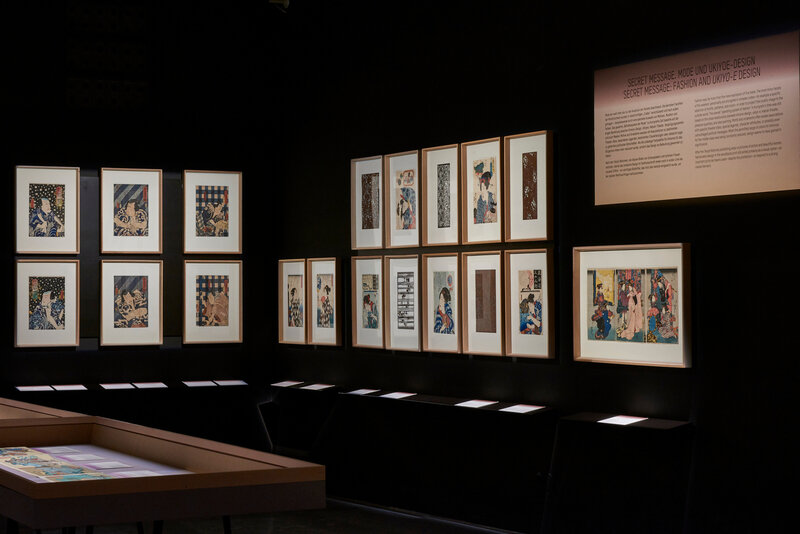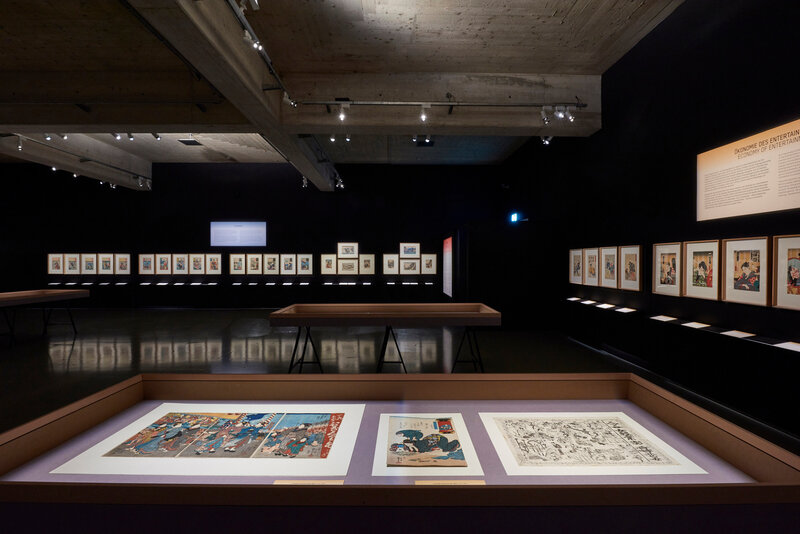The MAK Vienna opens an exhibition devoted to the late period of the ukiyo-e
Utagawa Kuniyoshi, The Spirit of Asakura Tōgo , 1851 © MAK / Georg Mayer
VIENNA.- For the 150th anniversary of Austrian-Japanese friendship the MAK exhibition KUNIYOSHI +: Design and Entertainment in Japanese Woodblock Prints is devoted to the late period of the ukiyo-e. The show’s main spotlight is on one of the most important and innovative artists of the nineteenth century, Utagawa Kuniyoshi (1797– 1861). Selected prints from the extensive woodblock print collection in the MAK show his works so to speak as creative response to the great political and social changes in Japan in the nineteenth century. The exhibition also deals with Kuniyoshi’s collaboration with contemporary artists, including Hiroshige and Kunisada, also his impact on the themes and style of the following generation in the Meiji period. Kuniyoshi’s multifaceted and innovative oeuvre is illustrated in eight sections.
Utagawa Kuniyoshi, Yu Qianlou (Yukenrō) from the series 24 Forms of Childlike Piety in China , around 1848 © MAK / Georg Mayer
Kuniyoshi is the central personality in the history of woodblock prints at the end of the Edo period (1603–1868). Together with other masters of the Utagawa school, including Utagawa Hiroshige (1797–1858) and Utagawa Kunisada I (= Utagawa Toyokuni III, 1786–1864) and often in cooperation with the entertainment industry, he produced created prints that were ground-breaking in both artistry and technique and enormously popular with the general public.
Kuniyoshi, Kunisada, and Hiroshige were all acclaimed ukiyo-e designers of their era; together they created extensive series such as had never been possible before. Cooperation and not competition was also the motto of the major publishing houses that made these extensive series possible. The works of the Utagawa school also attained hitherto unencountered sizes. For instance, a six-part, 38 x 150 cm print by Kuniyoshi from the MAK Collection gives us an idea of this new scale.
Utagawa Kuniyoshi, The Noble Lady Tokiwa from the series Life Stories of Wise and Virtuous Women , around 1842 © MAK / Georg Mayer
From the late eighteenth century on, the woodblock print is the form that most notably and frequently displays the increasing interest in the art scene outside Japan—despite the restricted access to information and originals. In his large series Twenty-Four Chinese Paragons of Filial Piety (ca. 1848), Kuniyoshi combines a traditional Chinese theme with European stylistic elements and compositions and uses western printed graphics from the seventeenth and eighteenth centuries as models.
Utagawa Kuniyoshi, "The Councilor Masatsune", poem 94 from the series Comparisons to the Ogura anthology of the hundred poems by a hundred poets , around 1845 © MAK / Georg Mayer
Further sections in the MAK exhibition show life in the great city of Edo—today Tokyo: fashion, theater, pleasure quarters, and nocturnal entertainment are reflected in the popular works of the Utagawa school. Kuniyoshi was a master in manoeuvering his way round the ever more restrictive censorship, which made direct allusions and even portrayals of well-known personalities impossible. Designers and publishers therefore opted for innocuous historical motifs with cryptic contemporary references.
Reality and fiction also intermingle in dream pictures and ghost stories—these types of pictures especially have a long tradition in the ukiyo-e, newly revitalized by Kuniyoshi and Kunisada.
Utagawa Kuniyoshi, "The girl: the evil vixen Kayō and the Indian prince" from the series Japanese-Chinese comparisons to the Genji novel , 1855 © MAK / Georg Mayer
Synthetically produced pigments enriched the color palette of the Japanese woodblock prints at the latest since the series Thirty-Six Views of Mount Fuji (post-1830) by Katsushika Hokusai (1760–1849), with their use of “Prussian blue” imported from Europe. The MAK exhibition shows Kuniyoshi’s use of this new, synthetically produced coloring, which made him the central figure in the technical renewal of the ukiyo-e.
Utagawa Kuniyoshi, "Daruma- ken game", 1847 © MAK / Georg Mayer
Woodblock Prints from the MAK Asia Collection The holdings of woodblock prints by Kuniyoshi and his contemporaries in the MAK Collection were mostly compiled around 1900. Occupying a special status here are the two collector personalities Heinrich Siebold (1852–1908) and Richard Lieben (1842– 1919). Siebold’s collection entered the MAK Asia Collection between 1892 and 1905; this was supplemented in 1922 with Lieben’s extensive and superlative ukiyo-e collection.
The exhibition is accompanied by the catalog KUNIYOSHI +: Design and Entertainment in Japanese Woodblock Prints by Mio Wakita-Elis and Johannes Wieninger, edited by Christoph Thun-Hohenstein, Mio Wakita-Elis, and Johannes Wieninger. German/English, ca. 144 pages with numerous color illustrations. MAK/Verlag für moderne Kunst, Vienna 2019. Available at the MAK Design Shop and online at MAKdesignshop.at for € 27.
Utagawa Kuniyoshi, "Bell of the Miidera Temple" from the series Collection of Striped Female Benkeis from the Freudenviertel , 1843/44 © MAK / Georg Mayer
Utagawa Kuniyoshi, "Tamakazura, the diver retrieves the pearls" from the series Comparison of depictions from the Genji novel and the flowing world , 1843–1847 © MAK / Georg Mayer
Utagawa Kuniyoshi, Today's Fashionable Taste , 1830–1840 © MAK / Georg Mayer
MAK exhibition view , 2019 KUNIYOSHI +. Design and entertainment in Japanese color woodcut. MAK DESIGN LAB © MAK / Georg Mayer
MAK exhibition view , 2019 KUNIYOSHI +. Design and entertainment in Japanese color woodcut. MAK DESIGN LAB © MAK / Georg Mayer
MAK exhibition view , 2019 KUNIYOSHI +. Design and entertainment in Japanese color woodcut. MAK DESIGN LAB © MAK / Georg Mayer
MAK exhibition view , 2019 KUNIYOSHI +. Design and entertainment in Japanese color woodcut. MAK DESIGN LAB © MAK / Georg Mayer
MAK exhibition view , 2019 KUNIYOSHI +. Design and entertainment in Japanese color woodcut. MAK DESIGN LAB © MAK / Georg Mayer

/https%3A%2F%2Fprofilepics.canalblog.com%2Fprofilepics%2F1%2F0%2F100183.jpg)
/https%3A%2F%2Fstorage.canalblog.com%2F03%2F02%2F119589%2F96711876_o.jpg)
/https%3A%2F%2Fstorage.canalblog.com%2F11%2F31%2F119589%2F94773502_o.jpg)
/https%3A%2F%2Fstorage.canalblog.com%2F20%2F83%2F119589%2F94772815_o.jpg)
/https%3A%2F%2Fstorage.canalblog.com%2F26%2F72%2F119589%2F75604929_o.jpg)
/https%3A%2F%2Fstorage.canalblog.com%2F59%2F60%2F119589%2F26458628_o.jpg)
















/http%3A%2F%2Fstorage.canalblog.com%2F51%2F86%2F119589%2F127782228_o.jpg)
/http%3A%2F%2Fstorage.canalblog.com%2F87%2F77%2F119589%2F121450336_o.jpg)
/image%2F1371349%2F20240422%2Fob_9e242e_telechargement-8.jpg)
/image%2F1371349%2F20240422%2Fob_389183_telechargement-2.jpg)